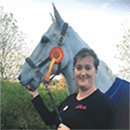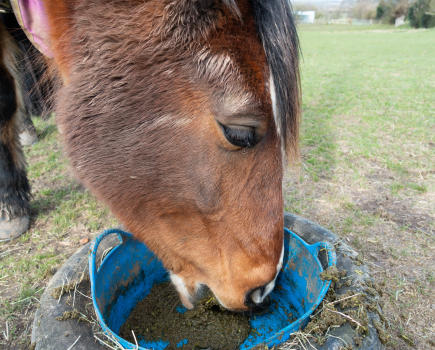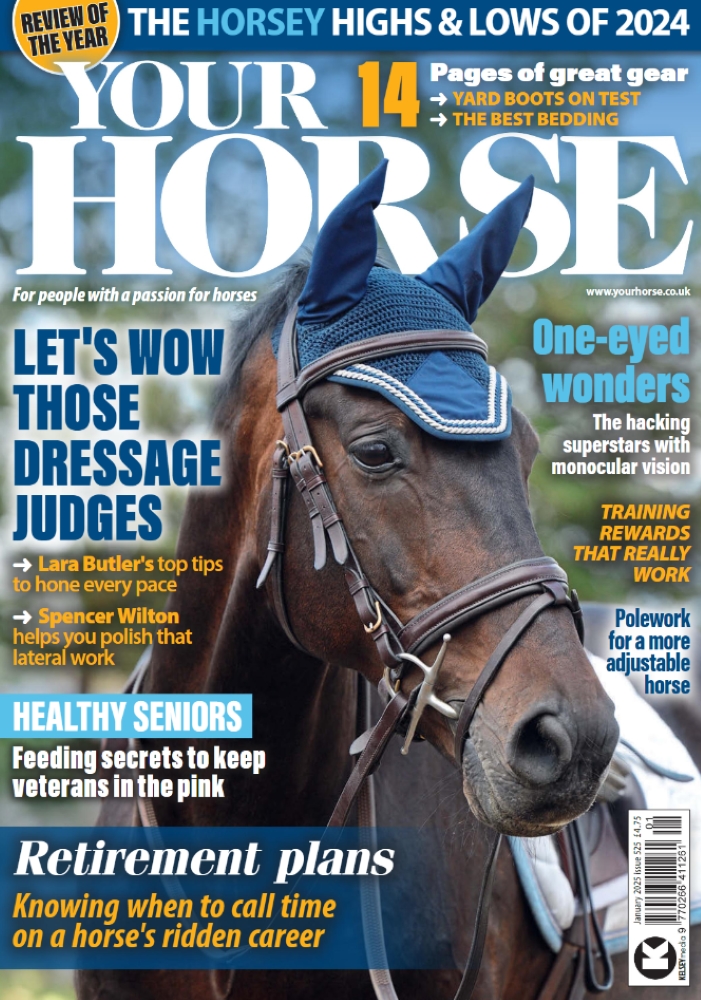Ad lib forage is the ideal scenario for horse’s who are a healthy weight. Feeding ad lib means their supply of hay or haylage, which must be the core of every horse’s diet, is plentiful and they won’t run out before the next time they see you.
Horses are naturally trickle feeders, which means the most appropriate diet is one that enables them to eat little and often. This is because horses are designed to eat all the time — and not twice a day or whenever you can get to the yard to give them a new haynet.
Yet modern life means it isn’t possible for most of us to be at our horses’ beck and call all day, topping up their forage ration when they need it.
According to independent equine nutritionist Donna Case, as a rule of thumb you should never leave a horse for longer than four hours without access to some sort of forage.
Of course, this isn’t an issue when the horse is turned out in a field with plenty of grass, but it does become more difficult when they are stabled or require their grass intake to be restricted for health reasons.
“For stabled horses, this timescale can become a challenge, so consider buddying up with a friend to provide hay/haylage nets little and often,” advises Donna. “You may find you need to get to the stables much earlier in the morning or later in the evening than you anticipated.”
Ad lib forage and horse diet
Splitting your horse’s forage into a number of different places, some on the floor and some in a haynet, for example, helps fulfil their need to ‘forage’ by looking for the food. It’s called cafeteria feeding, because the horse can choose where to eat and when.
Providing forage in this way has been found to offer many benefits to a horse’s diet, not least making their ration last longer and making it more interesting for them to eat.
However, ad lib forage is tricky to provide if your horse is greedy, and inclined to put on weight. This is when you need to get creative — and cafeteria feeding can still be really useful.
- Try feeding forage in trickle-hole haynets, for example, so that it takes longer to eat.
- Provide it in different parts of the stable so that the horse has to move around to find it.
- Soak hay to remove some of its nutrients.
- Consider including straw to bulk out your horse’s diet, which increases the amount of fibre they have to chew and eat, without a spike in calories.
“It can be useful to top up forage rations with straw, which is much lower in calories than hay or haylage,” confirms Donna.
Lower the risk of gastric ulcers
One of the best feeding tips I was ever given (from a vet) was to feed my horses a small amount of chaff or soft-chop forage about half an hour before riding.
It forms a mat in the horse’s stomach and helps to reduce acid splash back, in turn lowering the risk of gastric ulcers.
I find this particularly useful at a competition, when the ex-racehorses I have ridden over the years have tended to be too excited to eat the haynet in front of them. A scoop of chaff was too good to resist, though.
This is a good habit to get into if you ride your horse first thing in the morning (before work, for example), especially if your horse has run out of hay or stopped eating it a few hours earlier.
You can then ride confidently, knowing that your horse has a fibre mat in their tummy helping to keep them comfortable.
Bear in mind that horses who appear to be in good condition — and even those who are overweight — can suffer with gastric ulcers too.
It’s not just a disease that affects poor-doers and fit sport horses. The amount of time between eating forage and being exercised on an empty stomach are two risk factors, which can be managed with a good feeding programme.
Encourage chewing
Forage, chewing and gastric ulcers are intrinsically linked when it comes to diet and horse health.
Firstly, forage is the foundation of a horse’s diet and it should form the largest source of nutrition. It can be fed fresh in the form of grass, or preserved in the form of hay and haylage.
In the wild, horses forage on a variety of different plants, grasses, trees, and shrubs to fulfil some of their nutritional needs.
However, kept horses often don’t have access to these and so we owners need to compensate and ensure that they receive such essentials through forage and hard feed.
“Horses have an innate need to chew for 16-18 hours every day,” explains Donna.
“When a horse eats grass, hay or haylage, they have to chew for longer than when eating a typical mix or cube-based hard feed, which results in more saliva to help buffer the stomach and reduce the risk of gastric ulcers. This is just the very start in the role that forage plays in horse diet.”
It should be no surprise then, that forage is not only crucial in maintaining good digestive health, but also overall health and wellbeing.
“When health problems occur — perhaps a horse has lost or put on weight or colicked — people often turn to check the hard feed ration, but we must always ensure the forage ration is correct first,” says Donna.
“If your horse isn’t receiving enough, you may find that they struggle to maintain condition. Painful gastric ulcers become a high risk due to lack of saliva production and an empty stomach, alongside other issues such as colic.”
How much forage?
The amount of forage you will need to give will depend on its nutritional value and your horse’s overall condition and weight. The more nutrients you can supply from forage, the healthier they are likely to be.
“Total diet should be between 1.5% and 2.5% (on a dry matter basis) of a horse’s bodyweight in a 24-hour period,” advises Donna.
“Horses with a moderate condition score typically require around 2%, those dieting around 1.5% and those working harder or who struggle to maintain weight normally 2.5%. If you are able to and your horse’s body condition score allows it, feed ad-lib forage.”
As a guide, Donna suggests that a 500kg horse on a 1.5% ration would require around 9kg of hay per day once you have factored in dry matter content, or 11-12kg of haylage.
The latter is slightly higher to account for its extra water content. Grass also needs to be included in this figure, but during the winter most of the ration will come from conserved forage.
“Selecting a higher energy hay or haylage for those horses who struggle to hold weight or are working harder makes sense,” adds Donna, who runs her consultancy The Horse Feed Guru in Newmarket.
“For good doers, it would be better to choose a lower energy one to enable you to feed slightly more.”
Dry matter is the weight of your horse’s forage minus its water content. Different forage has a different dry matter weight. For example, grass has a higher water content and therefore lower dry matter weight than hay, so more must be consumed. Dr Laura Wilson talks more this topic here.
Carbohydrates in horse diet
Although it is the core of correct horse diet, forage alone rarely provides all the nutrients they need. So, how can we tell whether the diet we are giving our horse contains what they need?
A good place to start is by understanding the key components that horses and ponies need in their diets.
Carbohydrates provide the largest source of energy in your horse’s diet and are required for cell processes and basic functions, such as breathing and moving in the form of muscle contraction.
Excessive carbohydrates can lead to equine obesity, whereas deficiency can cause the horse to break down body reserves to supply necessary energy, leading to loss of body condition and muscle wastage.
Carbohydrates can be broadly categorised as ‘structural’ or ‘non-structural’:
Structural carbohydrates
These complex carbohydrates are fibre (or cellulose).
“Second to water, fibre is the most important component of your horse’s diet — it is, after all, what horses evolved to eat,” says nutritionist Clare Barfoot, research and development manager at Spillers Horse Feeds.
“Fibre is essential for gut health and the absorption of many nutrients. It cannot be digested by enzymes and must be fermented by microbes in the large intestine (hindgut) to produce volatile fatty acids, which are converted to energy.”
Non-structural carbohydrates
These simple carbohydrates are starch, sugar and frutan, which is the storage form of sugar in grass and other forages. Starch is broken down by enzymes in the small intestine, along with sugar.
“High starch and sugar diets may lead to excitability and/or play a role in clinical conditions such as colic, laminitis and tying up,” says Clare.
Protein in horse diet
This is required for the renewal of healthy cell tissue, milk production and is also a source of energy.
“Protein is made up of a chain or sequence of amino acids, which in your school biology lessons may have been referred to as the building blocks of life,” explains Clare.
“Proteins are differentiated by the type, structure and sequence of amino acids. There are 22 amino acids in total, 10 of which are essential (including methionine, lysine and threonine) in a horse’s diet.
“Essential amino acids can’t be synthesised [made] by the horse and must be provided in their diet,” continues Clare. “Protein is not a primary energy source for horses and will not cause or exacerbate conditions such as laminitis, tying up or excitability.
Fats and oils
While the natural diet of a horse doesn’t contain a large amount of fat, it is easily broken down in the small intestine and is well utilised as an energy source.
“These are sources of essential fatty acids and a concentrated source of energy,” says independent nutritionist Nikki Meggison.
“They are also a carrier for fat-soluble vitamins and are essential for working, performance, lactation, growth and slow-release energy.”
Clare Barfoot adds: “At 3.5 megajoules of digestible energy [MJ/DE] per 100ml, oil is around 2.5 times higher in energy compared to cereals, making it a good alternative for those horses who are sensitive to higher levels of starch in their diet.”
Vitamins in horse diet
“Although vitamins and minerals are required in relatively small amounts, they are involved in numerous essential bodily functions, including the transmission of nerve impulses, muscle contractions, immunity, bone health, enzyme composition and energy metabolism,” explains Clare.
Vitamins are classified as either ‘fat soluble’ (A, D, E and K) or ‘water soluble’ (B-complex and vitamin C) according to how they are absorbed, excreted and stored.
“Fat-soluble vitamins are not easily excreted and are stored either in the liver (A and D) or in fatty tissues (E and K),” says Clare. “Water-soluble vitamins, on the other hand, can’t be stored and are excreted when over supplied.”
Nikki adds: “Vitamins are vital for the health and wellbeing of the horse and are required for many metabolic processes and chemical reactions that occur within the body.”
Minerals
Minerals are classified as either ‘macro’ or ‘micro’, depending on the level at which they are required.
“These are an essential part of a balanced ration and are vital for optimum horse health and performance,” says Nikki. “They form the constituents of bones and teeth, are present in fluids and tissues and they play a vital role in biochemical reactions.”
Macro minerals include calcium, phosphorus and magnesium. Micro, which can also be called ‘trace elements’, are copper, zinc and selenium.
“Macro minerals are required in larger quantities of grams per day in horse diet, while micro minerals are required in much smaller quantities, typically milligrams per day,” states Clare.
It is possible to have too many vitamins and minerals in a horse’s diet.
“More doesn’t always mean better,” confirms Clare. “Some vitamins and minerals, including vitamins A and D, copper, zinc, iron, iodine and selenium, can be harmful if oversupplied. When it comes to feeding supplements, it’s wise to consult a nutritionist first.”
Antioxidants
Diets high in antioxidants are vital for supporting a horse’s immune system and encouraging healing. Providing access to forage is often thought to provide sufficient intake of antioxidants.
But while this may be true of diets for horses and ponies in the wild, the diet of a domesticated equine lacks such a rich variety of herbs and plants.
“Antioxidants are compounds which are able to neutralise the effect of unstable and highly reactive free radicals, helping to convert them into less harmful substances, thus protecting horse health,” says Sarah Osborne, corporate development director at Anpario Direct.
“It is essential to ensure that there is sufficient availability of antioxidants in your horse’s diet in order to meet the demand for neutralisation of free radicals and minimise the risk of oxidative stress.”
Vitamins E, C and selenium are well recognised for their antioxidant properties in horse diet.
“Vitamin E provides strong antioxidant defence and is often linked with selenium, which is an important trace mineral,” explains Sarah.
“The two work together supporting muscle and nerve problems in hard-working horses. Vitamin C also has antioxidant properties. However, as horse can form this internally, there is less need to supplement it.”
Key times when horses may be under oxidative stress are:
- When travelling
- When competing
- In older horses, as vitamin C production declines with age
- When a horse is sick
- Those who are immune compromised, a horse with allergies for example.
“It is important to know the nutritional formulation and, more specifically, the vitamin and mineral content of your horse’s diet. Over-supplementation of selenium and vitamin A can lead to toxicity,” warns Sarah.
Water in horse diet
Although not a nutrient, water is the most important, yet often the most overlooked, component of a horse’s diet and is involved is almost every physiological body process. Quite simply, a horse cannot survive without water.
“Water accounts for approximately 65% of body mass in mature horses and roughly 80% in foals,” says Clare Barfoot.
Having unlimited access to clean water is one of the golden rules of feeding. Whether it’s from a bucket in the stable, tank in the field or a natural water source like a stream, your horse should be able to have a drink whenever they need one. There are other easy to increase a horse’s water intake too:
- Soak hay or feed haylage, if suitable, as it has a higher water content.
- Provide a soaked bucket feed.
- Add water to hard feed for mixing.
If a horse isn’t receiving enough water in their diet, it can quickly lead to very serious health complications, including colic.
Balancing the diet
If you are giving your horse hard feed as part of their diet, there will be clear guidelines on the feedbag explaining how much of that feed you need to give. If you are feeding it in the full amount, you will be providing a balanced diet for your horse.
“Some people look at feed bags to assess the amount of a certain ingredient, but don’t then take into account the feeding rate,” explains Nikki. “Therefore, it may look like there isn’t much of a certain ingredient, but once you have fed the required amount, it will be meeting your horse’s needs.”
If you are not feeding the required amount, adding a feed balancer or a vitamin and mineral supplement may be necessary.
“Balancers take the stress out of buying feed because they come ready balanced and complete with everything your horse needs. Because they are concentrated, they are low in calories, which is particularly great for good-doers,” advises Nikki Meggison.
“However, the amount you give is really important to ensure that you are meeting your horse’s nutritional requirements. Even with feed balancers that are generally made to be fed at 100g per 100kg of bodyweight, many people don’t feed at these rates.
“A sprinkle or a handful is pointless as it isn’t meeting the horse’s nutritional needs. This is particularly important for those on a calorie-restricted diet who might have their grazing restricted and so aren’t getting additional nutrition from grass.”
Signs of a deficient diet
Signs that your horse is lacking something in their diet can depend on the ingredients they are deficient in. This can vary, but some common signs include:
- A dull coat
- Weight loss
- Dry skin
- Poor hoof quality
- Muscle loss
- Lethargy
Remember to factor in how much of your horse’s dietary needs are being fulfilled by hay and grass.
“An idea is to get your forage analysed,” suggests Nikki. “However, as long as you’re feeding a balancer or a supplement, you should be giving your horse everything they need.”
If you are considering adding a supplement to your horse’s feed, it is worth speaking to a nutritionist first. They will be able to evaluate your horse’s diet to ensure you’re not overfeeding certain ingredients, which could be a waste of money.
Forage walks
Another simple thing you can do to support your horse’s diet is encourage them to forage outside of their field — as long as it is safe to do so, of course.
“Owners can help by taking their horse on foraging walks and letting them pick at different hedges, bushes and trees,” says social scientist Tamzin Furtado who looked at how to improve the management of obesity in horses during her PhD at the University of Liverpool.
“Horses love sticky weed, cow parsley, dried nettles, hazel leaves, ash leaves, blackthorn and hawthorn, as well as dandelions, gorse, rosehips and willow.”
Before they died, I regularly took my two Thoroughbreds out for a forage walk. I’d ride Bee and lead Arnie, who was retired. It was a 30-minute hack to a lovely grassy track with hedges and trees to pick at. Arnie was on a lunge rein, so there was no risk of losing him. They loved it!










